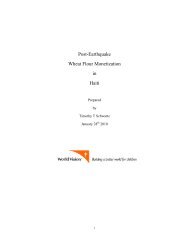Right to Livelihoods in Haiti
Focus on egg production and rural household livelihood strategies
Focus on egg production and rural household livelihood strategies
Create successful ePaper yourself
Turn your PDF publications into a flip-book with our unique Google optimized e-Paper software.
12<br />
Table 4: Biggest Reason For Eggs Losses<br />
Reason Count Percent<br />
Animals/preda<strong>to</strong>rs 50 55%<br />
Cannot f<strong>in</strong>d them 11 12%<br />
S<strong>to</strong>len 5 5%<br />
Other 25 27%<br />
Table 5: Animals that Eat Eggs (n=50)<br />
Type of Preda<strong>to</strong>r Count Percent<br />
Mongoose 21 42%<br />
Dog 13 26%<br />
Cat 9 18%<br />
Rat 4 8%<br />
Chicken hawk 3 6%<br />
Table 6 Explanation for "other reasons"<br />
respondent loses eggs (n=25)<br />
Number of<br />
Explanation<br />
Respondents<br />
Heat/sun spoils them 8<br />
Hen doesn't care for them 4<br />
Cold spoils them 2<br />
Noise of thunder 2<br />
Disease 1<br />
Dust spoils them 1<br />
They break 1<br />
They wash away <strong>in</strong> s<strong>to</strong>rms 1<br />
We do not put them <strong>in</strong> a coup 1<br />
I don't lose any 4<br />
The Fundamental Tenet of Survival <strong>in</strong> Rural <strong>Haiti</strong>: Low Cost & Low Risk<br />
Constra<strong>in</strong>ts <strong>to</strong> egg production at the level of rural household has <strong>to</strong> do with the strategies that farmers<br />
utilize <strong>to</strong> survive. Few if any households <strong>in</strong> rural <strong>Haiti</strong> depend on a s<strong>in</strong>gle production strategy. Rather, they<br />
depend on an array of productive endeavors (agriculture, lives<strong>to</strong>ck rear<strong>in</strong>g, fish<strong>in</strong>g, charcoal production,<br />
fruit trees, artisanship). Technology is alarm<strong>in</strong>gly simple. The <strong>to</strong>ols used <strong>in</strong> perform<strong>in</strong>g agriculture<br />
strategies are, for the vast bulk of the population, no more complex than picks, hoes, and machetes.<br />
Animals are free ranged <strong>in</strong> dry areas but <strong>in</strong> humid areas where agriculture is more common they are<br />
tethered <strong>to</strong> bushes with rope. One seldom sees barbed wire; rather, gardens, homesteads, and the rare<br />
corral are enclosed with wooden stick barricades or liv<strong>in</strong>g fences made of fast grow<strong>in</strong>g and malicious<br />
vegetation such a dagger-like sisal, cacti, and poison oak (ka<strong>to</strong>ch, kandelab, pit, pigwen and bawonet).<br />
Fish<strong>in</strong>g technology is largely rowboats, bamboo fish<strong>in</strong>g traps, and str<strong>in</strong>g nets. With the exception of the<br />
South, trac<strong>to</strong>rs are rare. Only <strong>in</strong> a few regions do farmers use ox as traction <strong>to</strong> plow fields. There are few<br />
pumps; farmers with gardens plots near <strong>to</strong> spr<strong>in</strong>gs and rivers sometimes manually haul buckets of water<br />
<strong>to</strong> irrigate crops, particularly vegetables <strong>in</strong> cool highland areas. The use of chemical or processed fertilizers<br />
and pesticides is almost entirely conf<strong>in</strong>ed <strong>to</strong> highland vegetable gardens and, <strong>to</strong> a lesser degree, beans<br />
(also considered a cash crop). The most important crops <strong>in</strong> the region are highly drought resistance,<br />
<strong>in</strong>tercropped and offer the advantage of provid<strong>in</strong>g year round harvests.xxii At least another 16 fruits trees<br />
add <strong>to</strong> the adaptability and subsistence security of the strategy. When all fails due <strong>to</strong> drought on<br />
catastrophic hurricane, crops fail and lives<strong>to</strong>ck dies, many rural households turn <strong>to</strong> charcoal production<br />
for sale <strong>in</strong> the city, the s<strong>in</strong>gle most important economic backs<strong>to</strong>p <strong>in</strong> times of crisis. In summary, the<br />
strategy described is emphatically focused on risk avoidance and long-term survival with<strong>in</strong> a regional<br />
economy; it is just as emphatically not focused on entrepreneurialism, maximiz<strong>in</strong>g profits, and short term<br />
exploitation of distant economies.<br />
Relations of Production and Gender<br />
In the harsh environmental and economic conditions described above people <strong>in</strong> the region organize labor<br />
around the household. With only the rarest exception, everyone liv<strong>in</strong>g <strong>in</strong> rural <strong>Haiti</strong> belongs <strong>to</strong> a<br />
multimember household. Mutual efforts of household members are what make the <strong>in</strong>tegrated livelihood<br />
strategies described above possible: garden plots tend <strong>to</strong> be scattered across multiple ecological zones
















